Cardinal (bird)
| Cardinals | |
|---|---|

| |
| Male northern cardinal | |
| Scientific classification | |
| Kingdom: | Animalia |
| Phylum: | Chordata |
| Class: | Aves |
| Order: | Passeriformes |
| Superfamily: | Emberizoidea |
| Family: | Cardinalidae Ridgway, 1901 |
| Genera | |
|
Piranga | |

Cardinals, in the family Cardinalidae, are passerine birds found in North and South America, Central America, and (mostly as migrants) the Caribbean. They are also known as cardinal-grosbeaks and cardinal-buntings.
The South American cardinals in the genus Paroaria are placed in the tanager family Thraupidae. On the other hand, DNA analysis of the genera Piranga (which includes the scarlet tanager, summer tanager, and western tanager), Chlorothraupis, and Habia showed their closer relationship to the cardinal family in a 2002 study.[1] The International Ornithological Committee (IOC), the American Ornithological Society (AOS), and the Clements taxonomy agree that the below 14 genera belong to the family but differ in their sequence and the number of species assigned.[2][3][4][5]
Species list[]
These 53 species and this sequence are recognized by the IOC as of July 2021:[2]
| hideImage | Genus | Living species |
|---|---|---|
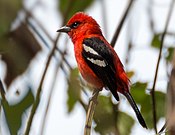 |
Piranga Vieillot, 1808 |
|
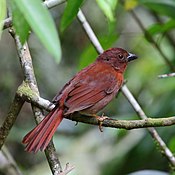 |
Habia Blyth, 1840 |
|
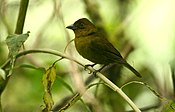 |
Chlorothraupis Salvin & Godman, 1883 |
|
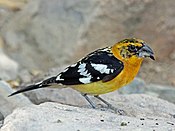 |
Pheucticus L. Reichenbach, 1850 |
|
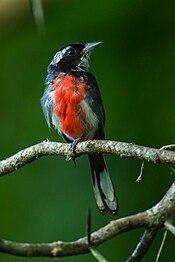 |
Granatellus Bonaparte, 1850 |
|
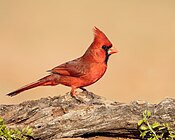 |
Cardinalis Bonaparte, 1838 |
|
 |
Caryothraustes L. Reichenbach, 1850 |
|
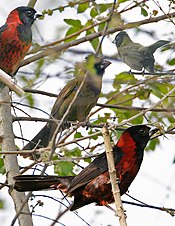 |
Rhodothraupis Ridgway, 1898 |
|
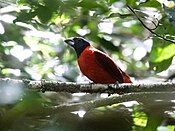 |
Periporphyrus L. Reichenbach, 1850 |
|
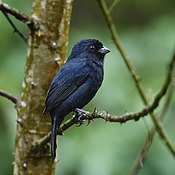 |
Amaurospiza Cabanis, 1861 |
|
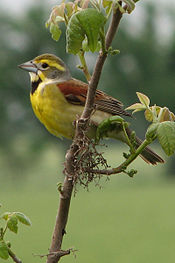 |
Spiza Bonaparte, 1824 |
|
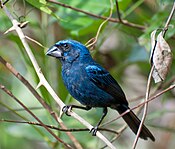 |
Cyanoloxia Bonaparte, 1850 |
|
 |
Cyanocompsa Cabanas, 1861 |
|
 |
Passerina Vieillot, 1816 North American buntings |
|
Biology[]
They are robust, seed-eating birds with strong bills. The family's smallest member is the 12-cm (4.7-in), 11.5-g (0.40-oz) orange-breasted bunting. They are typically associated with open woodland. The sexes usually have distinctive appearances. The northern cardinal type species was named by colonists for the male's red crest, reminiscent of a Catholic cardinal's biretta.[6]
The "North American buntings" are known as such to distinguish them from buntings of the Old World family Emberizidae. The name "cardinal-grosbeak" can also apply to the cardinal family as a whole.
Most species are rated by the IUCN as being of least concern, though some are near threatened.[7]
References[]
- ^ Yuri, T.; Mindell, D. P. (May 2002). "Molecular phylogenetic analysis of Fringillidae, "New World nine-primaried oscines" (Aves: Passeriformes)". Molecular Phylogenetics and Evolution. 23 (2): 229–243. doi:10.1016/S1055-7903(02)00012-X. PMID 12069553.
- ^ Jump up to: a b Gill, F.; Donsker, D.; Rasmussen, P. (July 2021). "IOC World Bird List (v 11.2)". Retrieved July 14, 2021.
- ^ "Check-list of North and Middle American Birds". American Ornithological Society. June 29, 2021. Retrieved August 9, 2021.
- ^ Remsen, J. V., Jr., J. I. Areta, E. Bonaccorso, S. Claramunt, A. Jaramillo, D. F. Lane, J. F. Pacheco, M. B. Robbins, F. G. Stiles, and K. J. Zimmer. Version 24 August 2021. A classification of the bird species of South America. American Ornithological Society. https://www.museum.lsu.edu/~Remsen/SACCBaseline.htm retrieved August 24, 2021
- ^ Clements, J. F., T. S. Schulenberg, M. J. Iliff, S. M. Billerman, T. A. Fredericks, J. A. Gerbracht, D. Lepage, B. L. Sullivan, and C. L. Wood. 2021. The eBird/Clements checklist of Birds of the World: v2021. Downloaded from https://www.birds.cornell.edu/clementschecklist/download/ Retrieved August 25, 2021
- ^ Duchesne, Bob (September 21, 2012). "Proliferation of cardinals a fairly recent event". Bangor Daily News. Archived from the original on October 6, 2014.
- ^ Search "cardinalidae" at IUCN Red List Archived June 27, 2014, at the Wayback Machine for more info.
Other reading[]
- ffrench, Birds of Trinidad and Tobago. ISBN 0-7136-6759-1.
- Hilty, Steven L. (2003). Birds of Venezuela. London: Christopher Helm. ISBN 0-7136-6418-5.
- Klicka, John; Burns, Kevin; Spellman, Garth M. (December 2007). "Defining a monophyletic Cardinalini: A molecular perspective". Molecular Phylogenetics and Evolution. 45 (3): 1014–1032. CiteSeerX 10.1.1.550.1550. doi:10.1016/j.ympev.2007.07.006. PMID 17920298.
- National Geographic Field Guide to the Birds of North America. ISBN 0-7922-6877-6.
- Stiles and Skutch. A guide to the birds of Costa Rica. ISBN 0-8014-9600-4.
External links[]
| Wikimedia Commons has media related to the cardinal family. |
| Wikispecies has information related to Cardinalidae. |
- Cardinalidae videos, photos and sounds on the Internet Bird Collection
- Cardinalidae sounds on xeno-canto.org
- Northern cardinal (bird information) on petinfospot.com
- Northern cardinal, including sound and video clips, on Cornell Lab of Ornithology
- Cardinalidae
- Birds of the Americas
- Taxa named by Robert Ridgway
